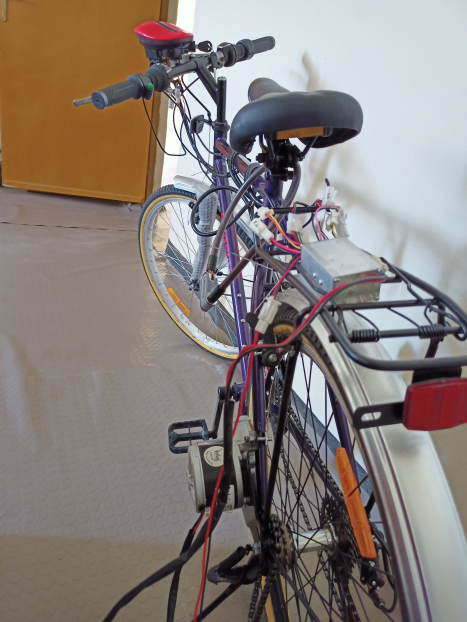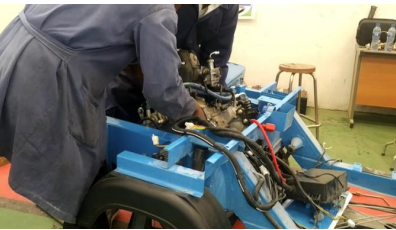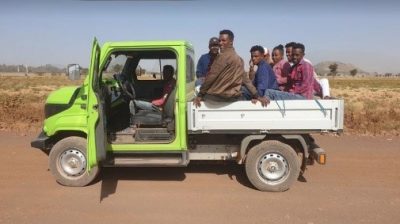
Urban development in Ethiopia has resulted in a rise in the number of cities, along with the indicated concentration of population in cities and existing urban agglomerations. So rise in demand for vehicles is also obvious for inter-city or intra-city mobility of goods and passengers. The present work deals with the activity carried out to develop transport for individuals and physically challenged people at a minimum price without the necessity of license, which is electric bicycle (e-bike). Basically the integration of traditional bicycle with dc gear motor, controller etc in order to help in propelling known as E-bike. An electric bike, sometimes known as an e-bike, is motor assisted pedal bikes represent one of the fastest growing segments of the transport market. Over 31 million were sold in over the last years. As usage continues to grow, so too will the need for further research. This project particularly focused on conversion of traditional manual bike to motor assisted transport utility vehicle. Our main focus is to develop transport rather than recreational especially for individuals and physically challenged people at minimum price without necessity of license. in this project we are planning to use the minimum basic component required to convert the traditional cycle in to E-bike as shown in above figure in order to control the price of E-bike. If we comfortable with more budget many additional features can added like antitheft alarm, wireless on off with personal identification, application based access etc etc. But by considering the community general demand our aim is to provide cheaper transportation initially its costs up to tens of thousands but at the last we are expecting it 11000 birr on road for users. While if we compare motor bikes available in the market which costs from 50000 birr to 100000 birr. The main factors responsible for power consumption in propelling a bicycle are rider’s weight, cargo weight if any, wind resistance, the frictional resistance of tire with surface and drag coefficient of paths well as elevation angle of the path at normal speed. By considering all these parameters total resistance faced by bike and torque required to pull the wheel has been calculated from mathematical model specifically for local surrounding. The electric propulsion required to assist the rider to carry 92 kg of gross mass at the maximum speed of 25 Km/hr with 10 degrees of elevated path has been calculated approx 213 watt and verified with simulation results carried out in MATLAB/SIMULINK platform. In addition to that basic model for controller circuit been designed using Proteus and implemented using locally available components in market. As this prototype developed at ASTU can me utmost useful because of its versatile implementation on any kind Bicycles kid bicycle, full size as well as possible to design for physically challenged persons. Further the prototype has already been demonstrated at ASTU as well as in MOSE Exhibition held on 12-16 July 2021 and it was highly appreciated

The ever increasing use of petroleum and its derivatives to power internal combustion engines is believed to have greatly contributed to global warming, noise pollution, and emission of pollutant gases. Finding an alternative to power vehicles is therefore a crucial issue to be addressed; to these end electrical powering alternative is believed to have promising results. The current project aims in converting a conventional engine-operated three-wheeler to a battery-operated electric motor-driven type. Motor size and battery pack capacity estimations is done, in addition, modifying the vehicle to support the battery pack and DC motor, assembling the battery and motor including the controller and other accessories were among the tasks performed. Optimal selection and matching of the basic components; electric motor and battery applying basic mathematical relations were used for the design of the electrical conversion system. The converted electric three-wheeler uses an electric brushless direct current motor with 1.2kw power. The battery pack is with 60V nominal voltages with Lead-acid batteries with 75Ahr rating connected in series. Testing the performance characteristics of the developed electric three-wheeler vehicle were done after drive train speed ranges was redesigned and modified as per the intended running speed of the converted three-wheeler. Layout of the basic components used in the modification and repositioning of the modified electric three-wheeler was chosen and developed considering weight balance and easy accessibility of the controls for users. From the experimental level road test, it was found out that the maximum velocity of the converted electrical three wheeler (E3W) obtained was 30km/hr at 4th gear. On a level road, the maximum current draw reaches 20A at stable speed conditions and when moved in gradient road, the maximum current draw reached 50A. The test confirmed that the chosen battery pack is capable of driving the E3W for 50 km with one charge without dropping of battery pack voltage below 52.5 volts. Based on the performance test performed, the three wheeler’s running cost prior to conversion was 0.8667 Ethiopian birr per kilometer driving, whereas the converted vehicle has a running cost of 0.079 Ethiopian birr per kilometer drive, a reduction of 0.7877 birr per one kilometer drive. The converted electric three-wheeler provides a much cheaper transportation alternative and zero pollutant emissions as the batteries are being charged by hydro generated electricity

TUM (Technical University of Munich), GIZ(Deutchche Gegellschaft fur Internationale Zusammenarbeit) and ASTU express closer collaboration to develop implementation and operation strategies for electric mobility. Within 2 years, the partners aim to give a qualified assessment of potentials for the electric vehicles in the target regions on a bigger scale. As a result of its strong collaboration with Technical University of Munich (TUM), ASTU has received an e-Car for its aCar Mobility joint Research Project. This project constitutes three main domain, namely Energy domain, Mobility domain and Service domain. The aCar Mobility’s Project Goal is assessing the potential of electric mobility to enhance transportation challenges of rural farming communities, especially enable smallholder farmers in Ethiopia. The aCar Mobility Research Project’s objective is to develop implementation and operation strategies for electric mobility as a technological enabler of sustainable and self-reliant economic development in rural Sub-Saharan Africa (SSA), especially for smallholder farmers. While this project exclusively investigates the operational phase of the vehicle life cycle, it succeeds two others looking into the development of a bespoke vehicle for this use case -the aCar- and production strategies for electric vehicles in SSA respectively.
Communities in sub-Saharan Africa (SSA) face a multitude of interconnected challenges rooted in their lack of access to electricity. This is especially evident in rural parts of the region where nonprofits are attempting to lessen the negative impacts associated with in access to electricity grids. Most of these efforts are based on decentralized solutions, able to function without direct connection to major energy sources. In the context of SSA, many (if not most) of said decentralized solutions have come to rely on solar energy–and with reason. With its overabundance of sunlight (some regions average 6.5kWh/m2 of solar radiation per day), sub-Sahara is seemingly the perfect locale for solutions reliant on photovoltaic (PV) technologies. However, it remains unclear whether decentralized solar-powered solutions will be able to tackle the challenges facing SSA today (and in the future). This is especially true of the difficulties facing the continent’s 33 million smallholder farmers who, even when given access to solar energy, continue to encounter barriers to economic success. It is our belief that new sustainable modes of transportation, as well as solar energy, should be leveraged in order to improve the lives of smallholder farmers and, possibly, help reinvigorate SSA’s agricultural sector altogether. Within the SolChargE project, the DTH will be jointly developed with South Africa’s Stellenbosch University (SBU), Ethiopia’s Adama Science and Technology University (ASTU), supported by the French Commissariat à l’énergie atomique et aux énergies alternatives (CEA), and subsequently tested in rural communities in South Africa (SA) and Ethiopia (ET). The project SolChargE focuses on the issues of (1) farmers’ (especially female heads of household’s) inability to reach markets and extension services, (2) children (especially girls’) inability to attend school, (3) community members’ (especially pregnant community members’) lack of access to healthcare as well as additional use cases.